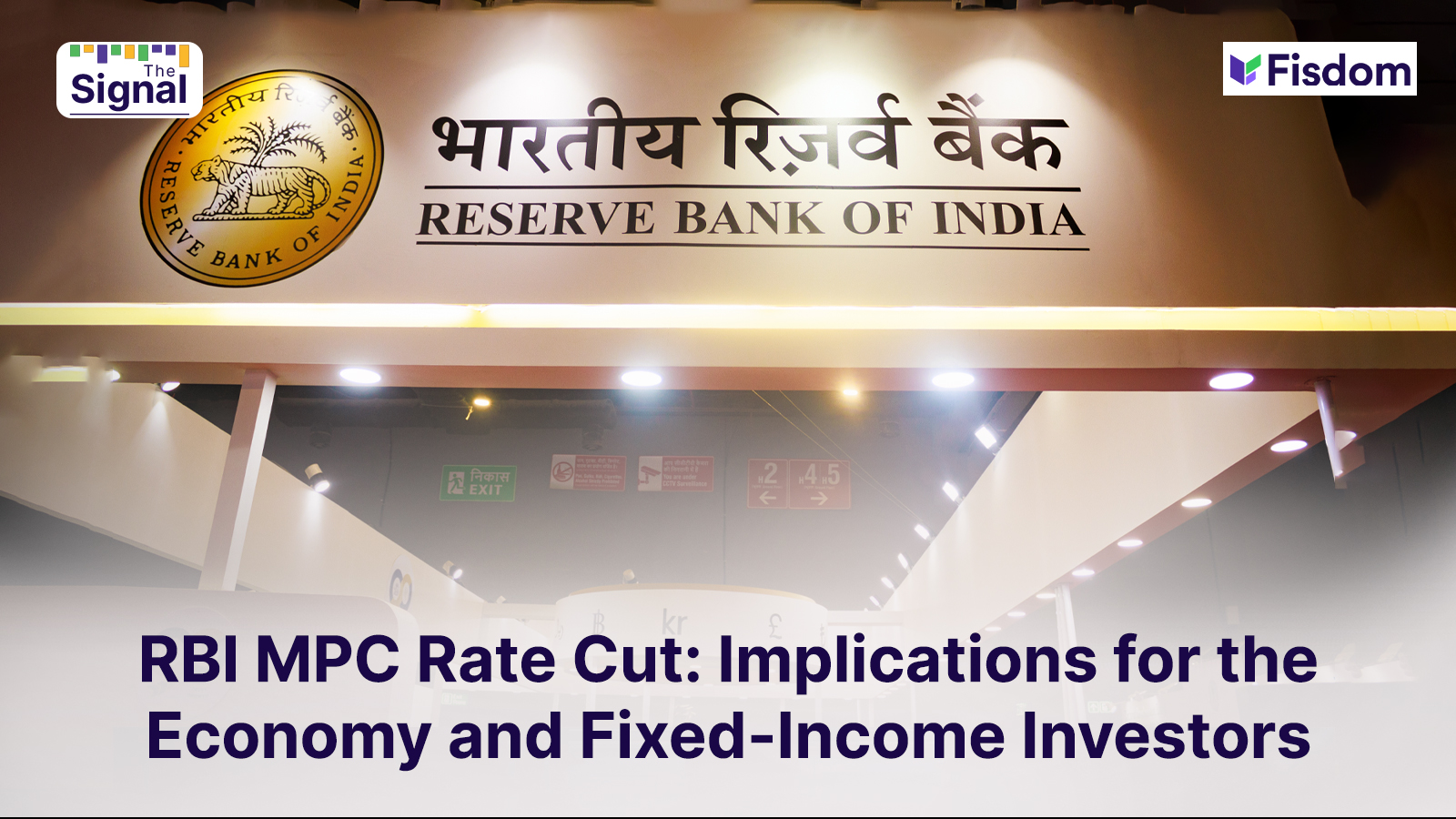
RBI MPC Rate Cut: Implications for the Economy and Fixed-Income Investors
India’s economic trajectory towards the $5-trillion mark has faced hurdles in recent months, with slowing GDP growth, moderating inflation, tighter liquidity conditions, and financial market volatility. In response, the Reserve Bank of India (RBI), during its Monetary Policy Committee (MPC) meeting on February 6-7, 2025, announced a 25-basis point reduction in the repo rate, bringing it down to 6.25%. This marks the first rate cut in nearly five years and comes shortly after the Union Budget introduced tax relief measures to stimulate consumption.
Key Takeaways from the RBI’s Policy Action
The central bank’s decision reflects a balance between known economic risks—such as a slowdown in domestic growth—and unknown global uncertainties, including inflation trends and monetary policy shifts in advanced economies. Despite the rate cut, the RBI has maintained a neutral stance, signaling that future policy decisions will be data-driven and contingent on evolving economic conditions.
However, the timing of this move presents challenges. The strengthening US dollar and narrowing interest rate differentials between India and the US have already triggered capital outflows, putting additional pressure on the Indian rupee, which has depreciated significantly in recent months.
Economic Impact of the Rate Cut
- Slowing GDP Growth
India’s economic expansion is projected to slow to 6.4% in FY25, marking a four-year low after recording 8.2% growth in FY24. The slowdown is primarily driven by:
- Weakening consumer demand
- Sluggish private investment
- A cautious approach to government spending
While the rate cut is expected to stimulate borrowing and economic activity, structural challenges such as stagnant wages and high food prices continue to weigh on household consumption and corporate profitability.
- Inflation Trends and RBI’s Outlook
The moderation in consumer price index (CPI) inflation, which eased from 5.5% in November to 5.2% in December 2024, has provided some relief to policymakers. The outlook for food inflation appears positive, supported by strong Kharif production and Rabi sowing progress.
However, the recent depreciation of the rupee could increase imported inflation, particularly in fuel prices. Despite this risk, core inflation remains below 4%, giving the RBI confidence that overall inflation will continue to decline through FY26.
- Liquidity and Bond Market Dynamics
Systemic liquidity remains tight, even after the RBI’s CRR cut in December, which infused ₹1.2 lakh crore into the banking system. The RBI has implemented additional liquidity-boosting measures, but capital market volatility and global monetary policy shifts remain key concerns.
The Indian 10-year government bond (G-Sec) yield has fallen from 7.09% in February 2024 to 6.76% in February 2025, fueled by foreign portfolio investment (FPI) inflows, particularly after India’s inclusion in JP Morgan’s GBI-EM index. The RBI’s rate cut is expected to provide further support for bonds, potentially leading to lower yields.
What Should Bond Investors Do?
With the rate cut cycle beginning, fixed-income investors should consider adjusting their bond and debt fund strategies to optimize returns.
- Short-Term Debt Funds
- Short-term bond yields may decline, leading to moderate returns for ultra-short and short-duration debt funds.
- Investors with a short-term investment horizon can still benefit from stable returns in these funds, but should manage expectations for yield compression.
- Long-Term Debt Funds & Gilt Funds
- Long-duration bonds tend to benefit the most from rate cuts, as existing bonds with higher coupon rates become more attractive.
- Gilt funds and long-term debt funds may see capital appreciation due to falling yields, making them an attractive option for investors willing to tolerate volatility.
- Experts predict that the 10-year G-Sec yield could fall towards 6.55%, further enhancing the appeal of these funds.
- Corporate Bond and PSU Bond Funds
- High-credit-quality corporate bond funds and PSU bond funds are expected to gain from the rate cut.
- Investors looking for a balance of stability and moderate returns can consider these funds, particularly those with 1-3 year maturities.
- Rupee Depreciation and Fixed-Income Risks
- Currency depreciation could impact foreign investment flows, making bond yields volatile.
- Investors should be mindful of global economic shifts, particularly US Fed policy changes and global interest rate trends, which could influence the RBI’s next moves.
Conclusion: Navigating the Changing Interest Rate Environment
The RBI’s rate cut marks the beginning of a potential easing cycle, aimed at supporting growth while managing inflation risks. For bond investors, this presents an opportunity to capitalize on falling yields, particularly in long-term debt funds and gilt funds. However, with global uncertainties and rupee depreciation in play, it is crucial to maintain a diversified fixed-income strategy to balance returns and risk exposure.
Market this week
| 03rd Feb 2025 (Open) | 07th Feb 2025 (Close) | %Change | |
| Nifty 50 | ₹ 23,319 | ₹ 23,560 | 1.0% |
| Sensex | ₹ 77,064 | ₹ 77,860 | 1.0% |
Source: BSE and NSE
- Indian equity markets extended gains for the second consecutive week ending February 7, despite volatility driven by US tariff policy uncertainty, mixed corporate earnings, and the RBI’s expected 25 bps rate cut.
- Foreign Institutional Investors (FIIs) remained net sellers, offloading ₹8,852.31 crore worth of equities, while Domestic Institutional Investors (DIIs) absorbed some pressure, buying ₹6,449.67 crore.
- The Indian rupee hit a fresh record low of 87.59, closing at 87.42 per dollar on February 7, down 81 paise from the January 31 closing of 86.61.
Weekly Leaderboard
| NSE Top Gainers | NSE Top Losers | ||||
| Stock | Change (%) | Stock | Change (%) | ||
| IndusInd Bank | ▲ | 6.91 % | Trent | ▼ | (11.88) % |
| Bajaj Finance | ▲ | 5.93 % | ITC Ltd | ▼ | (6.85) % |
| Adani Ports & SEZ | ▲ | 5.72 % | Britannia Industries | ▼ | (6.36) % |
| Shriram Finance | ▲ | 5.22 % | HUL | ▼ | (5.67) % |
| JSW Steel | ▲ | 4.98 % | TATA Consumer | ▼ | (4.55) % |
Source: BSE
Stocks that made the news this week:
- The real estate sector saw a strong rally after the government announced a major tax relief, exempting income up to ₹12 lakh from taxation. This move is expected to boost homebuyer sentiment and drive demand. Major real estate stocks, including Prestige Estate (+5%), Phoenix Mills (+4.7%), and Macrotech Developers (+3%), recorded gains, pushing the BSE Realty Index up by 1.7%. Additionally, the government’s ₹15,000 crore allocation under SWAMIH Fund 2 to complete stalled projects further strengthened investor confidence in the sector.
- On the other hand, capital goods stocks declined by nearly 2% after the government revised capex for FY25 down to ₹10.18 lakh crore in the Budget. This dampened market sentiment, reflecting concerns over reduced infrastructure spending. However, the finance minister announced a simplification of tariff structures, cutting the number of tariff rates from 15 to 8, which is expected to promote exports. Additionally, the government will launch a State Investment Index in 2025 to rank states on investment-friendliness.
- Agriculture stocks surged as the government unveiled measures to strengthen agri-infrastructure, crop productivity, and farmer credit support. The finance minister announced a six-year mission for self-reliance in pulses, particularly focusing on tur, urad, and masur. Under the Dhan Dhanya Yojana, the government, in partnership with states, will work to enhance productivity, promote crop diversification, and improve post-harvest infrastructure. These initiatives are expected to benefit 1.7 crore farmers, providing both short- and long-term credit support.














